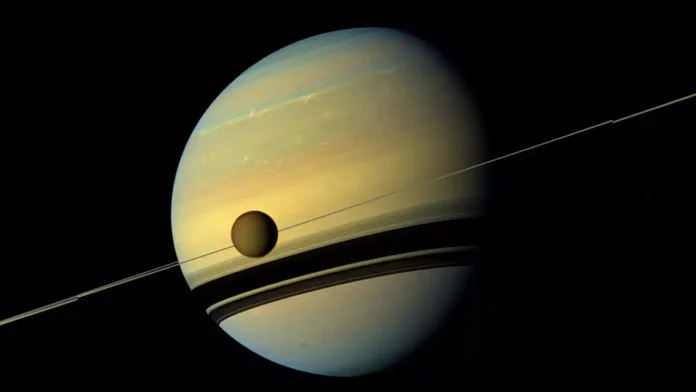Saturn‘s largest moon, Titan, has long intrigued scientists with its dense atmosphere and Earth-like landscapes. Recent research conducted by scientists at the University of Hawai’i has shed new light on the potential for life on this enigmatic moon. The findings suggest that Titan’s unique chemical composition and environmental conditions could make it a prime candidate in the search for extraterrestrial life.

The Fascinating World of Titan
Titan is the only moon in our solar system with a dense atmosphere, composed primarily of nitrogen with traces of methane and other hydrocarbons. Its surface is dotted with lakes, rivers, and seas of liquid methane and ethane, creating a hydrological cycle similar to Earth’s water cycle but with different chemicals.
One of the most intriguing aspects of Titan is the presence of complex organic molecules in its atmosphere and on its surface. These molecules are considered the building blocks of life, raising questions about the moon’s potential to support life forms.
University of Hawai’i’s Groundbreaking Research
The team of scientists at the University of Hawai’i conducted extensive studies to understand the chemical processes occurring on Titan. Using advanced computational models and data from previous missions like NASA’s Cassini-Huygens, they simulated the atmospheric reactions that could lead to the formation of prebiotic molecules.
Their research revealed that cosmic rays and ultraviolet sunlight interacting with Titan’s atmosphere could drive the synthesis of complex organic compounds. These compounds might accumulate on the surface and potentially create environments conducive to life.

The Possibility of Methane-Based Life Forms
One of the most exciting hypotheses arising from this research is the possibility of methane-based life forms, or “methanogens,” existing on Titan. Unlike Earth, where water is the solvent for biological processes, life on Titan might rely on liquid methane and ethane.
The University of Hawai’i’s findings suggest that if life does exist on Titan, it would be fundamentally different from life on Earth. Such organisms would have adapted to survive in extremely cold temperatures and utilize hydrocarbons instead of water.
Implications for Astrobiology
The discovery of potential life-supporting conditions on Titan has significant implications for the field of astrobiology. It expands the scope of environments where life might exist, encouraging scientists to consider non-water-based life forms in their search for extraterrestrial life.
Titan’s unique environment challenges the traditional understanding of habitability, which often focuses on the “Goldilocks zone” where liquid water can exist. The moon demonstrates that life might find a way in conditions previously thought to be inhospitable.

Future Missions to Titan
The promising results from the University of Hawai’i’s research have spurred interest in future missions to Titan. NASA’s Dragonfly mission, scheduled to launch in 2027, aims to explore Titan’s surface using a rotorcraft lander. Dragonfly will study the moon’s chemistry, atmospheric conditions, and potential signs of life.
This mission could provide invaluable data to confirm the hypotheses generated by the recent studies. By analyzing the organic compounds on Titan’s surface and searching for biosignatures, Dragonfly could answer some of the most profound questions about life beyond Earth.

Conclusion: Titan as a Window to the Universe
The new insights into Titan’s potential to harbor life open exciting avenues for exploration and understanding of the universe. The research underscores the importance of studying diverse celestial bodies to comprehend the possibilities of life in different forms.
As scientists continue to unravel the mysteries of Titan, we move closer to answering the age-old question: Are we alone in the universe? The findings not only enhance our knowledge of Titan but also inspire a broader perspective on where and how life could exist beyond our planet.

